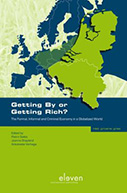Getting By or Getting Rich? The Formal, Informal and Criminal Economy in a Globalized World

Author: Pietro Saitta, Joanna Shapland, and Antoniette Verhage (Eds.)
Publisher: The Hague, Eleven International Publishing, The Green Grass / Het groene gras Series, 2013, 422p.
Reviewer: Anita Lavorgna | May 2014
What are the benefits and the disadvantages for workers in informal or even criminal economies? In these economies, do workers get rich or do they merely engage in survival strategies? These questions link together Pietro Saitta, Joanna Shapland, and Antoniette Verhage’s edited volume, which explores how people make choices and practice informality according to the available opportunities.
The book opens with an introduction by Saitta outlining the basic themes addressed by the various contributions and explaining that the volume aims at “contributing to the debate in a critical perspective” by looking at both “individuals in powers” and “the survival strategies of those who are pushed at the margins” (page 7). The introduction is followed by eighteen chapters exploring different and heterogeneous types of activities, ranging from street vendors and catering services to prostitutes and timber traffickers. Many of these chapters were originally presented as papers during a conference held in September 2012, and arranged by the research group Social Analysis of Security of Ghent University.
The book is successful in showing that formal and informal economies are not a matter of black and white, but they rather overlap and are often difficult to distinguish; to borrow Saitta’s words, what can be observed is the “hybridization of formal and informal” (page 4). The major strengths of the book are its interdisciplinarity, its presentation of valuable overviews of different countries’ socio-political situations, and the fact that it successfully draws on a wide range of theoretical backgrounds and frameworks. Another positive feature is the thorough attention, at least in most of the contributions, to the conceptualizations used – for instance, in the depiction of weaker actors not only as victims but as rational agents. Even if the book has an almost entirely European focus (in particular, most chapters focus on Italy and Belgium) because of the origin of most authors, the fact that it takes into consideration countries such as Brazil and Congo and the global relevance of the issues addressed do give the volume a more international scope.
Overall, the contributions illustrate a great diversity of cases with respect to the type of illegal economy considered, the degree of illegality, and the characteristics of the geographical areas considered. Some contributions are particularly successful, such as the ones by Signorino on the economic characteristics of the demand for usury, Bisschop on the illegal tropical timber trade, Klima on the informal economy in the hotel and catering industry in Belgium, and Coletto on Brazilian street vendors. However, other contributions seem to suffer a little bit from their origin as conference papers. Some of them, indeed, present ongoing studies, and the methodologies used are sometimes not adequately described. The editing could also have been more rigorous, both stylistically – for instance, the abstracts have different lengths with one containing references – and in terms of content. There is a golden thread that runs throughout the book, but it would have been useful to make it more evident in certain chapters. Moreover, the volume might have benefited by an organization into sections. For instance, it might have been appropriate to group together some chapters that offer meaningful insights on the effects of the economic crisis on informal economic activities.
Even with these weaknesses, the book offers an original and engaging account of the nature of informal economies. The conclusions suggested by Verhage and Shapland, by underlying the dynamism of informal economies and suggesting that “we must expect in future a more plural economy, in which, for some individuals, households and businesses, the formal and the informal may march hand in hand” (page 402), should stimulate debate. The volume is part of Elsevier’s “het groene gras” (i.e., “the green grass”) series, which is primarily aimed at a criminological audience. But this book might actually be of more interest to readers interested in interdisciplinary research, rather than to a specialized audience.


